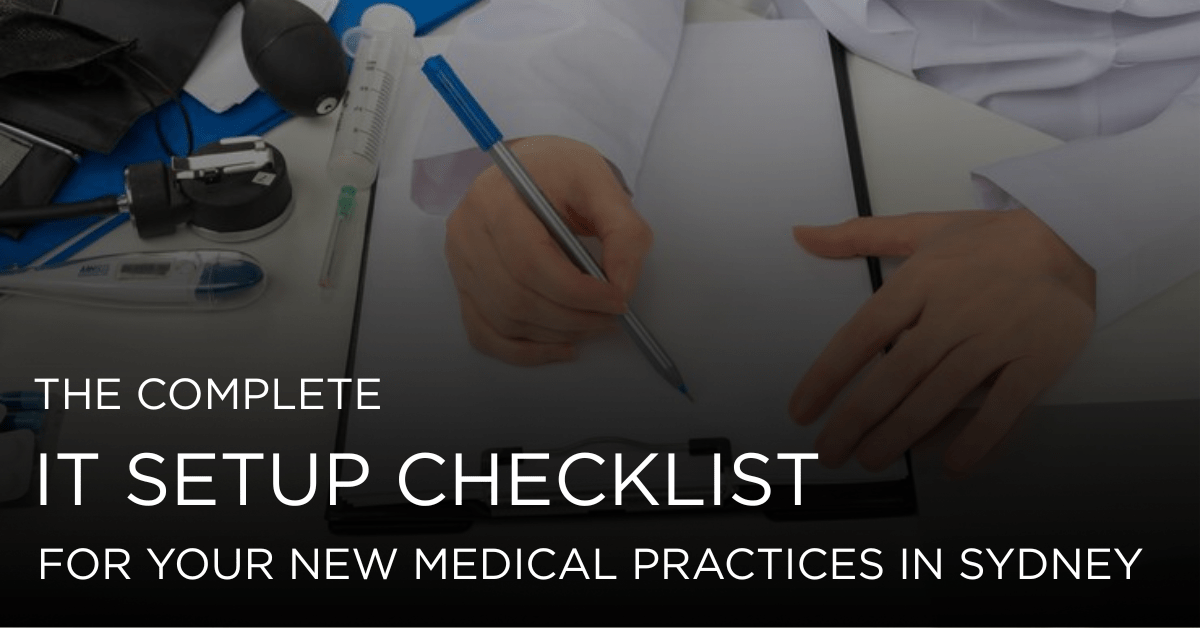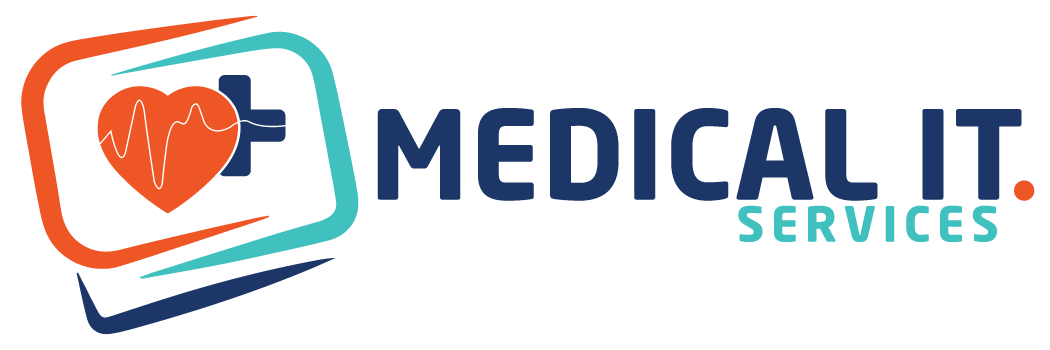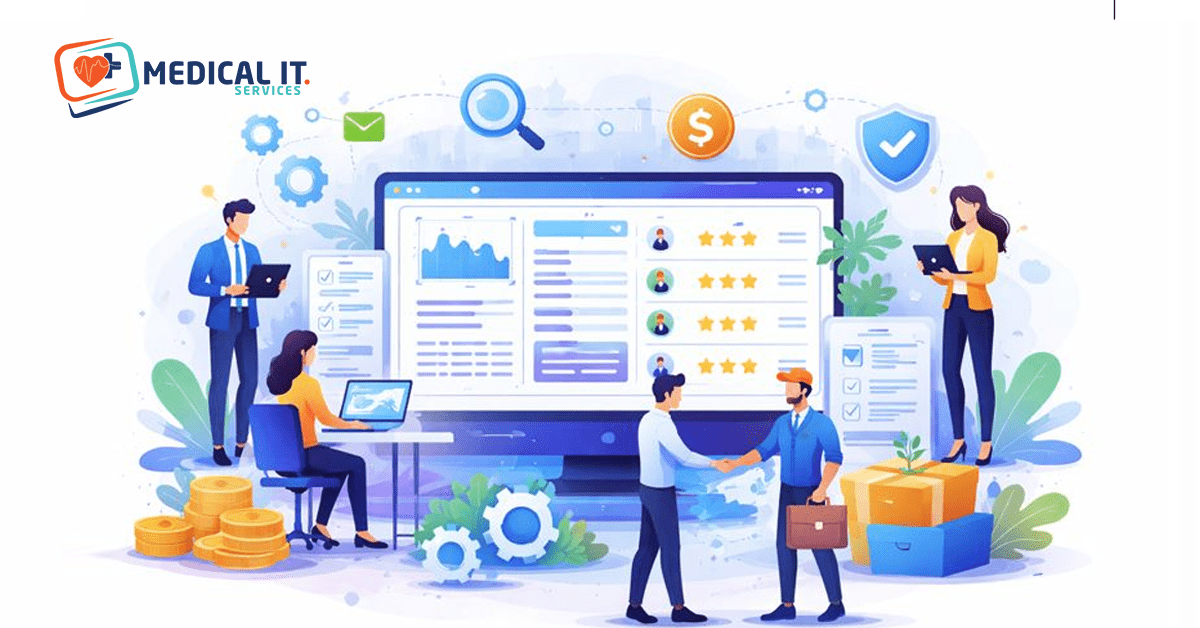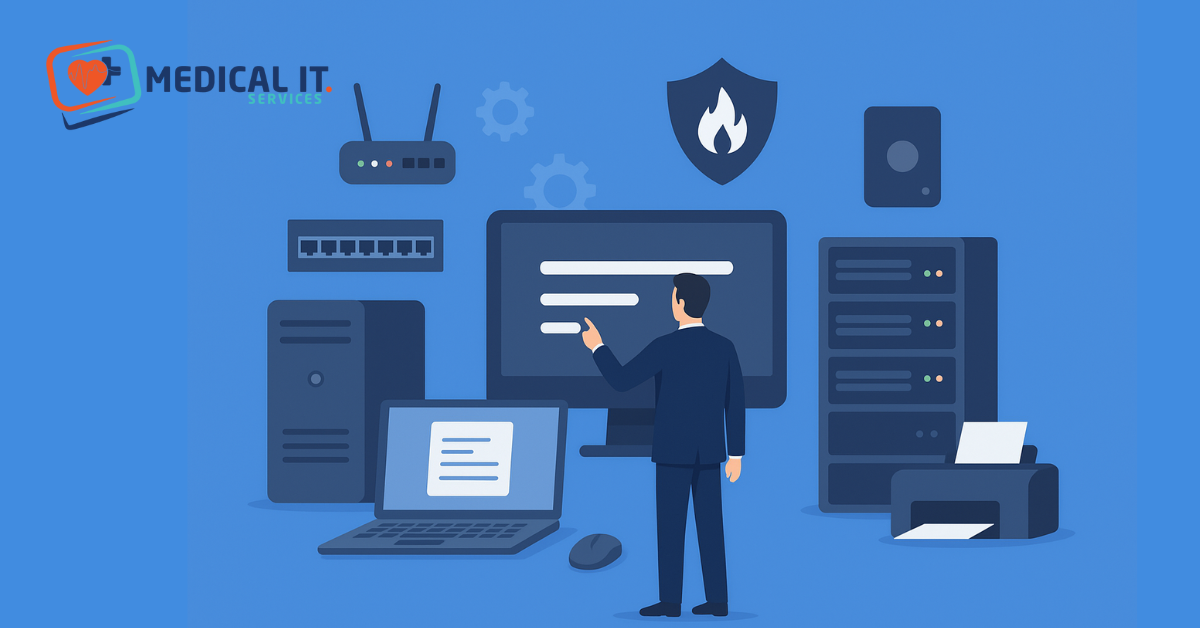In today’s modern business environment, every company must work with different vendors or suppliers to…

The Complete List of IT Setup for Your New Medical Practices in Sydney
Starting a new Medical Practices in Sydney is an exciting venture. You’ve found the perfect location, assembled a fantastic team, and are ready to provide exceptional care to your patients. But in today’s digital age, the backbone of any successful clinic isn’t just medical expertise—it’s a robust, secure, and reliable IT infrastructure.
A poorly planned IT setup can lead to daily frustrations, security vulnerabilities, and compliance nightmares. Conversely, a well-designed system works seamlessly in the background, allowing you to focus on what you do best: patient care.
This comprehensive checklist is your essential guide to building a future-proof IT foundation for your new medical practices in Sydney. We’ll walk you through every critical step, explaining the “why” behind each item in simple, easy-to-understand English.
Why a Specialized IT Setup is Non-Negotiable for Medical Practices
Unlike a standard business, a medical practice handles highly sensitive information. Your IT system isn’t just about email and internet; it’s the guardian of patient health records, appointment schedules, billing information, and diagnostic data. It must be:
- Secure: To protect against data breaches and cyberattacks.
- Reliable: To avoid costly downtime that disrupts patient appointments.
- Compliant: To adhere to Australian privacy laws, including the Privacy Act 1988 and the Australian Privacy Principles (APPs).
- Efficient: To streamline workflows for doctors, nurses, and administrative staff.
Phase 1: Pre-Opening Planning & Strategy (The Foundation)
Think of this phase as the blueprint for your entire practice. You wouldn’t start building a house without a detailed plan, and the same goes for your IT setup. Rushing into buying gadgets and software without a strategy is a surefire way to waste money, create security risks, and end up with a system that fights you instead of helping you.
This stage is all about asking the big questions and making informed decisions. It’s where you decide what kind of practice you want to be from a technological standpoint.
Choosing Your Digital Hub (Practice Management Software – PMS):
This is the single most important software you will buy. It’s the central nervous system of your practice. It handles everything: patient records, appointments, billing, and Medicare claims. You need to choose between big names like Best Practice, MedicalDirector, or Zedmed. But it’s not just about the brand; it’s about the fit. Does it feel intuitive? Can your receptionists see themselves using it all day? Does it connect easily with your preferred pathology lab or imaging centre? Book demos, involve your head nurse and practice manager in the decision, and don’t be afraid to ask the sales reps tough questions about support and training.
The Cloud vs. Server Dilemma:
This is a fundamental choice. Do you want your patient data stored on a physical server in a closet at your practice (on-premise), or do you want it hosted securely online (cloud-based)?
A Local Server gives you full control and can be very fast inside the practice. But it’s a big upfront cost, it requires physical space, and if it breaks, your entire practice grinds to a halt until it’s fixed.
The Cloud means you access your software through a web browser, like online banking. The benefits are huge: you can access it from anywhere (great for checking something from home), the IT company managing the cloud handles all the updates and security, and there’s no big metal box to worry about. You typically pay a monthly subscription per user. For most new medical practices in Sydney, the cloud option offers a simpler, more modern, and often more secure starting point.
Budgeting Realistically:
It’s easy to budget for the obvious things like computers but forget the hidden costs. Your IT budget needs two parts:
Upfront Costs (CapEx):
Computers, servers, network hardware, cabling, and initial setup fees.
Ongoing Costs (OpEx):
This is what people forget. This includes your monthly PMS subscription, your network support Sydney contract, internet bill, phone system costs, and antivirus software licenses. See this ongoing fee as an essential insurance policy for your business.
Phase 2: Core Hardware & Infrastructure (The Nervous System)
This is where your plan becomes physical. It’s all the tangible parts that make up the backbone of your practice’s technology. Getting this right means a fast, reliable system. Getting it wrong means daily frustration and constant, expensive fixes.
The Veins and Arteries: Structured Cabling: This is the most boring but most critical part. You might be tempted to just use Wi-Fi for everything, but that’s a mistake. A professionally installed wired network is like the foundation of your house—you don’t see it, but everything rests on it. A certified cabler will run high-quality (Cat6 or better) Ethernet cables from a central cabinet to every single desk, nurse station, and treatment room. This provides a rock-solid, fast, and secure connection for your most important devices. Wi-Fi is for convenience; cables are for business.
The Brain’s Core: Your Server (If you need one): If you went with a server-based PMS, this machine is the heart of your operation. This isn’t a regular office computer; it’s a powerful, resilient machine designed to run 24/7. It has redundant power supplies (so if one fails, the other keeps going) and its hard drives are configured in a RAID array (so if one drive dies, no data is lost, and you can replace it without downtime). It lives in a locked, ventilated cabinet, not under a reception desk.
The Tools of the Trade: Computers & Peripherals:
Consultation Rooms: Here, you need small, quiet, and easy-to-clean computers. All-in-One PCs (like a screen with the computer built-in) are perfect because they have fewer cables, take up less space, and are easy to wipe down.
Reception: Standard desktop PCs with good quality monitors are ideal for handling administrative tasks all day.
Printing/Scanning: A commercial-grade Multi-Function Printer (MFP) is a workhorse. A key feature is “secure print release.” This means when a doctor prints a sensitive patient referral, it doesn’t just come out of the printer for anyone to see. They have to walk to the printer and tap their ID card to release the job. This is a simple but crucial privacy feature.
Phase 3: Connectivity & Communications (The Voice)
This phase is about how your practice talks to the world and how the world talks to you. It’s about ensuring these conversations are clear, reliable, and professional.
Your Gateway to the World: Internet Connection: For a modern practice, a slow or unreliable internet connection is a disaster. You need a business-grade NBN plan. The key difference between a business and a home plan is the Service Level Agreement (SLA)—a promise from the provider on uptime and repair times. Even more crucial is redundancy. Having a backup 4G/5G internet connection that kicks in automatically if your main NBN fails is a game-changer. It means you can still process payments, look up patient records, and use the phone system even during an outage.
Professional Communication: The Phone System (VoIP): Gone are the days of clunky old phone systems. Voice over IP (VoIP) uses your IT networks to make calls. It’s cheaper, smarter, and more flexible. When a patient calls, they can be greeted by a professional automated menu (e.g., “Press 1 for appointments, press 2 for results”). Calls can be easily transferred between rooms, sent to voicemail that is delivered via email, and even forwarded to a doctor’s mobile phone if they are between clinics. It presents a incredibly professional image.
Controlled Access: Wi-Fi Networks: You must provide Wi-Fi for patients, but you must also protect your clinical systems from it. The solution is to create multiple separate networks:
Staff-Secure: A hidden, heavily encrypted network for all practice devices. This is on the “trusted” side of your firewall.
Guest-Patient: A completely separate network that grants internet access only. It has no ability to see or touch any of your computers or servers where patient data lives. This isolation is a basic, non-negotiable security practice.
Phase 4: Security & Data Protection (The Armour)
In healthcare, your data is your most valuable asset—and it’s also your biggest liability if it’s stolen. This phase is about wrapping that data in impenetrable armour. You are a custodian of deeply sensitive information, and protecting it is both a legal and ethical duty.
The Moat and Drawbridge:
The Firewall: A basic router from an electronics store is not enough. You need an enterprise-grade firewall. This is a specialised hardware device that sits between your practice network and the internet, acting as a super-intelligent guard. It doesn’t just let traffic in and out; it meticulously inspects every single data packet, blocking known threats, preventing staff from accidentally visiting malicious websites, and stopping hackers from getting in. It’s your first and most important line of defence.
The Bodyguard:
Endpoint Protection: Every computer in your practice (an “endpoint”) needs more than just antivirus. You need advanced endpoint protection. This software actively hunts for suspicious behaviour, like a file trying to encrypt itself (the sign of a ransomware attack), and shuts it down instantly. It also protects against phishing attacks and malware. This is your last line of defence on each individual device.
Your Unbreakable Insurance Policy: Backups:
If ransomware gets through your firewall and endpoint protection, your backups are what save you. The golden rule is the 3-2-1 Backup Strategy:
- 3 copies of your data (your live data + two backups).
- 2 different types of media (e.g., one backup on a NAS device in the practice, and one in the cloud).
- 1 copy off-site (the cloud backup protects you from fire, flood, or theft that would destroy both your live system and a local backup).
Crucially, you must test your backups regularly. A backup you haven’t restored from is just a hopeful guess.
Keys to the Kingdom:
Access Control: The simplest security step is often the most ignored. Every single staff member must have their own unique login. No shared passwords. Ever. Furthermore, staff should only have access to the information they absolutely need to do their job (the “principle of least privilege”). A receptionist doesn’t need access to all clinical notes. Finally, enable Multi-Factor Authentication (MFA) everywhere you can. This means even if a password is stolen, a hacker would need a code from the staff member’s phone to get in. It blocks 99.9% of automated attacks.
Phase 5: Implementation, Support, and Growth
Your system is planned and installed. Now, you need to make sure it works perfectly on day one and continues to work perfectly for years to come. This is about people and processes.
Professional Installation: This is not a DIY project. Expert Sydney IT services with healthcare experience don’t just plug things in; they configure your it networking for optimal performance and security. They ensure your server is set up correctly, your Wi-Fi has full coverage, and your firewall rules are tight. They make it all work together seamlessly.
Your IT Safety Net: The Support Contract: Your relationship with your IT provider doesn’t end on opening day. Technology is not static. Things will need updates, and occasionally, things will break. An ongoing network support Sydney contract is your guarantee of help when you need it. Look for a provider that offers:
Proactive Monitoring: Their systems watch your server 24/7, often fixing small issues before you even know they exist.
A Help Desk: A number you can call for quick help without being charged a huge fee.
Clear Response Times: A promise of how quickly they will respond to a “critical” issue versus a “low priority” one.
This peace of mind is worth every penny.
Training Your Human Firewall: Your staff can be your strongest defense or your weakest link. All the best technology in the world can’t stop a staff member from clicking a bad link in a phishing email. Conduct regular, simple training sessions. Teach them how to spot suspicious emails, why strong passwords matter, and the importance of following data handling procedures. Empower them to be part of your security solution.
Planning for Tomorrow: Your practice will grow. You’ll add more staff, see more patients, and maybe even open a second location. Your IT system must be able to grow with you. Work with your IT provider to plan for the future—when to add more storage, when to upgrade computers, and how new technologies might benefit your practice down the road. This proactive approach ensures your technology always supports your ambition, instead of holding it back.
Conclusion
Setting up the IT for your new medical practices in Sydney is a complex but manageable process. The key is to treat it with the same importance as your medical equipment and your team.
By following this checklist, you move from a reactive, panic-driven approach to a strategic, confident one. You invest in security that protects your patients and your reputation. You build reliability that ensures your practice runs smoothly every single day. And you establish a partnership with expert Sydney IT services that gives you peace of mind.
Your goal is to create a practice where technology empowers excellence in healthcare, not hinders it. By laying this strong foundation, you ensure that your practice is built for success, security, and growth from the very first patient you see.



